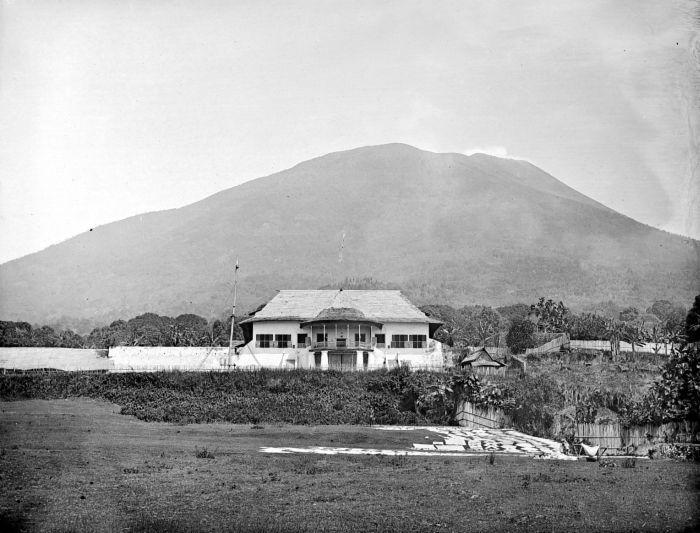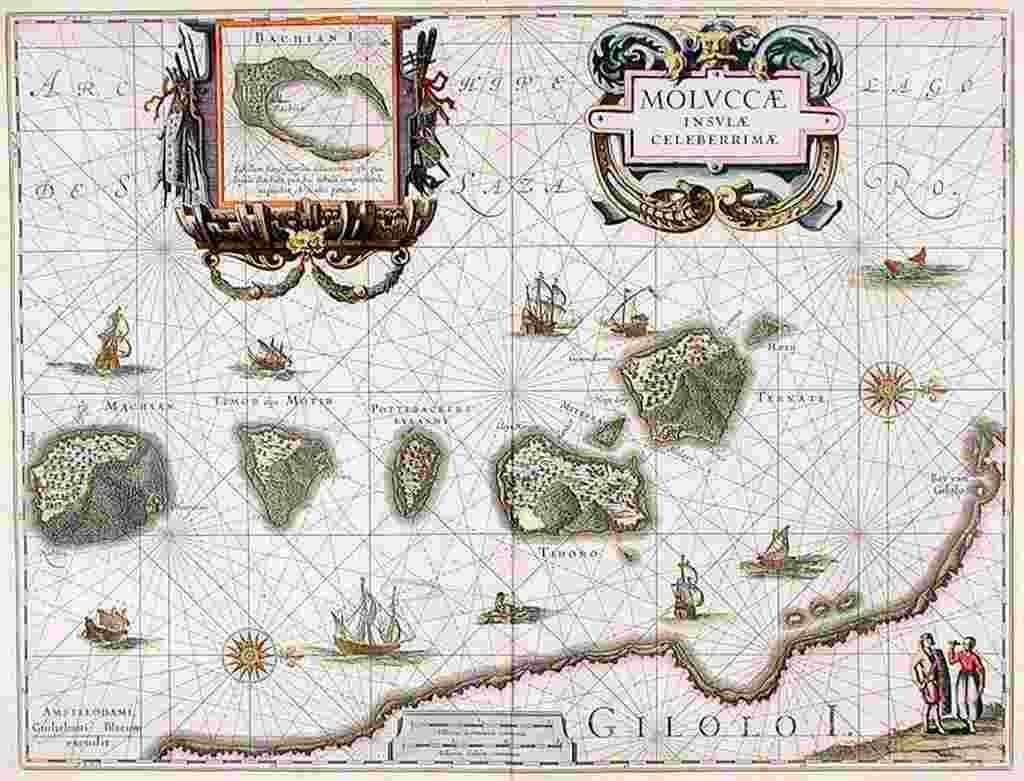Kingdom of Ternate (1257–Present)
The Kingdom of Ternate (Sultanate of Ternate) or the Gapi Kingdom is one of the 4 Islamic kingdoms in the Maluku Islands and is one of the oldest Islamic kingdoms in the archipelago. Its founder was named Malamo Cico in 1257.
Ternate is an island in eastern Indonesia, belonging to the Maluku archipelago, west of Halmahera. Administratively included in the province of North Maluku. This mountainous island that rises to a height of 1,715 meters in Gamalama, had a population of 80,000 in 1990 on an area of about 65 km².
Partly because of its trade-dependent culture, Ternate was one of the first places in the region to spread Islam, which originated in Java in the late 15th century. However, the influence of Islam in the region dates back to the late 14th century. Initially the belief was limited to the small ruling family of Ternate and gradually spread to the rest of the population.
History of The Kingdom of Ternate
Year 1257
The Sultanate of Ternate or the Gapi Kingdom is one of the 4 Islamic kingdoms in the Maluku Islands and is one of the oldest Islamic kingdoms in the archipelago. Its founder was named Baab Mashur Malamo in 1257.
The Sultanate of Ternate had an important role in the eastern region of the archipelago between the 13th century and the 19th century. The Sultanate of Ternate enjoyed glory in the middle of the 16th century thanks to the spice trade and military power. In his heyday, his reign stretched to include the Malukus, northern, eastern and central Sulawesi, the southern part of the Philippine archipelago as far as the Marshall Islands in the Pacific.
Read also: Indonesian Cuisine Rich in Flavors and Spices | Most Famous Traditional Foods
Year 1486-1500
With the conversion of its ruler Zain al-‘Abidin (1486-1500) around 1495, under the influence of the Muslim kingdom of Gresik on Java, Ternate was the first state in Maluku to convert to Islam.
But Ternate’s historical importance lies primarily in its role as North Maluku’s main storehouse, in a region traditionally derived from Europe’s most sought-after spices, cloves and nutmeg.
Cloves (Syzygium aromaticum) are native to this area. Nutmeg (Myristica fragrans) has long been an export product from northern Maluku. The author estimates the introduction of nutmeg in Europe in the 6th century. In South Asia, nutmeg is given a Sanskrit name indicating its ancient use in the region.
As for cloves, the Ramayana, probably written around 200 BC, mentions it. After all, it was known to the Romans in the 1st century AD, because Pliny the Elder described it in his writings. More generally, sources from ancient Egypt, China, India and Mesopotamia refer to unknown spices.
An archaeological discovery suggests that the clove trade with the West may actually have started much earlier. Indeed, cloves were found among the charred remains on a burnt kitchen floor at the Mesopotamian site of Terqa in present-day Syria, dated to 1700 BC.
16th century
Until the 16th century, clove production remained limited in northern Maluku. For thousands of years, Indonesian and Asian traders went looking for it. From the 16th to the 19th centuries, Ternate was the reason why the Portuguese, Spanish, British, and eventually the Dutch sought control of the region and its precious spices.
The Portuguese established their first permanent establishment in the Moluccas in Ternate in 1522. From Ternate, they succeeded in asserting their superiority in the Moluccan spice trade throughout the 16th century. Periods of conflict with the king and residents of Ternate alternated with periods of peaceful cooperation.
In the early 16th century, the Dutch competed with Muslim traders from the west of the Indonesian archipelago for the spice trade. In 1605, they succeeded in capturing the Portuguese fort in Ternate. In 1630, they established a competing port in Ambon.
17th century
During the 17th century, the Dutch allied in Ternate against the Portuguese and the Spanish. Their goal was to control the spice trade. For Ternate, the importance of this alliance lies in the framework of its competition with the Tidore Sultanate.
In the 1670s, the VOC (Dutch East India Company) allied with the Bugis prince Arung Palakka and conquered the Makassar kingdom of Gowa and the sultanates of Ternate and Tidore. During the 17th century, the Dutch finally expelled all other Asian and European traders from the Moluccan spice trade.

Meal for the Dutch of the King of Ternate, 1601. Anonymous, Public domain, via Wikimedia Commons
The Dutch immediately came into conflict with Ternate. In the late 17th century, a treaty between the VOC and the Sultan of Ternate, which it defeated, stipulated that cloves would no longer be planted in northern Maluku. Trade is now concentrated in the center of Maluku, on the islands surrounding Ambon. During the 18th century, the Dutch aim was to isolate Ternate, Tidore, and northern Maluku from the outside world and destroy the clove trees in northern Maluku for more controllable areas. Central Moluccas.
Late 17th century
Since the end of the 17th century, the Netherlands is no longer only a competitor, among others, in the spice trade in eastern Indonesia. They have become a colonial power. During the 18th and 19th centuries, the Dutch colonial government attempted to secure the cooperation of the Moluccan princes. European goods, such as coins, armor, weapons, and cloth were offered as gifts to the Allied courts.
Language
The native language of Ternate and neighboring islands is very different from most other Indonesian languages which are generally included in the Austronesian language family. From the 1890s, it was recognized that the Ternate, Tidore and certain Halmahera languages formed the same group, the North Halmahera languages.
In 1915, Van der Veen demonstrated that these languages were not Austronesian. Efforts are underway to incorporate these “North Halmahera families” into the so-called West Papuan ensemble. In 1988, Voorhoeve found that Ternate was spoken in Ternate, Hiri, Talimau and Moari (two islands in the Kayoa archipelago) and on the west coast of Halmahera. Currently, the number of speakers in Ternate itself is more than 30,000 people.
The consequence of the dominance of the Sultanate of Ternate at one time over the region was the dominance of potions in the world of magic and healers.
In Ternate, the oldest written document in modern Malay known to date, is a letter written in 1521 by Sultan Abu Hayat to King John III of Portugal, which is now kept in the Arquivos Nacionais Torre do Tombo of Lisbon. The Malay dialect used in Ternate is strongly influenced by the vocabulary and syntax of the West Papuan language.
Palace
The old sultan’s palace was abandoned between 1781 and 1813, when construction of the existing palace (kadaton) began. It has been restored in a semi-colonial style and is now partly a museum and the sultan’s house.

Keraton (Sultan’s palace) in the city of Ternate, Indonesia. Kainjock, CC BY-SA 4.0, via Wikimedia Commons
The museum exhibits the genealogy of the Ternate royal family from 1257, a collection of Portuguese and Dutch helmets, swords and armor, as well as memorabilia from previous Sultans.
 View Post
View Post
Palace of the Sultan of Ternate. Between 1900 and 1940. Tropenmuseum, part of the National Museum of World Cultures, CC BY-SA 3.0, via Wikimedia Commons
Inheritance
The Sultanate of the Eastern Archipelago which was controlled by Ternate had indeed collapsed since the mid-17th century, but the influence of Ternate as a kingdom with a long history continued to be felt for centuries later. Ternate has a very large share in the culture of the eastern archipelago, especially Sulawesi (north and east coasts) and Maluku. These influences include religion, customs and language.
As the first kingdom to embrace Islam, Ternate played an important role in efforts to enter and introduce Islamic Sharia to the eastern part of the archipelago and the southern part of the Philippines. The form of the sultanate’s organization and the application of Islamic law, which was first introduced by Sultan Zainal Abidin and then applied by his successors in the 16th century, became the standard followed by the entire Moluccan kingdom without any significant changes.

Marriage of the Sultan of Ternate at Bacan. Between 1930 and 1936. Tropenmuseum, part of the National Museum of World Cultures, CC BY-SA 3.0, via Wikimedia Commons
The success of the people of Ternate under Sultan Baabullah in expelling Portugal in 1575, was the first indigenous victory of archipelagic policy over Western powers. The 20th century writer Buya Hamka praised the victory of the people of Ternate for delaying Western occupation of the archipelago for 100 years while strengthening the position of Islam. If Ternate had not stopped European political and missionary efforts, the eastern part of Indonesia might have become a Christian center like the Philippines.
Ternate’s position as an influential kingdom helped raise the degree of Ternate language as a lingua franca in various areas under its influence. Professor EKW Masinambow, in his text “Ternate Language in the Context of Austronesian and Non-Austronesian Languages”, stated that Ternate had the greatest influence on the Malay language used by the people of eastern Indonesia. 46% of Manado Malay vocabulary comes from Ternate. Ternate Malay or North Maluku Malay is now widely used in Eastern Indonesia, especially North Sulawesi, the East Coast of Central and South Sulawesi, Maluku and Papua with different dialects.
Sultan Abu Hayat II’s two original letters to the King of Portugal, the first written between 27 April and 8 November 1521 and the second in early 1522, are recognized as the oldest Malay manuscripts in the world after the Tanjung Tanah manuscript. Abu Hayat’s letters are currently housed in the Lisbon Museum, Portugal.
Ternate Sultanate Memorial Museum, the center of the royal splendor of the Kingdom of Ternate
The Kedaton Sultan of Ternate Museum is a center for discovering the splendor of the royal heritage of the Sultanate of Ternate. This building was founded in 1813 by Sultan Muhammad Ali as the Sultan’s palace.
Designed by a Chinese architect, it is structured in an octagonal shape and covers an area of 1500 square meters. The building stands on a hill of orange trees in the form of a reclining lion, its face facing the sea and its back facing the majestic Mount Gamalama. In this building is the memory of a kingdom and the history of government from its inception and development, before being destroyed by colonial nations.
The artifacts of the Kedaton Ternate Museum include various items ranging from geology, archeology, history, technology, fine arts, and many more. Although the Sultanate of Ternate collapsed in the mid-17th century, the influence of its power is still felt today. Ternate has made a great contribution to the culture, customs and religion of the eastern islands of the archipelago, namely Sulawesi and Maluku.
He also played a major role in the Islamization of the eastern and southern parts of the Philippines. This museum exhibits many valuable relics such as the golden throne of the Sultande of Ternate. There are also gems, precious stones, and a gold crown decorated with diamonds, emeralds, and rubies. “Alquran”, the oldest manuscript in Indonesia is also among the objects to be found. Among the collections of European heritage, this museum also has a unique and sacred crown; the only one of its kind in Indonesia and even in the world.
This is because the crown contains live human hair that is still growing. Every year, on Eid al-Adha, a haircut ceremony is held. The crown and hair are said to be 500 years old, dating back to the reign of the first Sultan. the indigenous people of Ternate call the crown in their local language “Stampa”.
Reading sources: PinterPandai, Smithsonian Libraries and Archives
Photo credit: Author: Willem Janszoon Blaeu (1571-1638) (Public Domain). Source: http://www.donaldheald.com/s12772.html via Wikimedia Commons
Photo description: the earliest map of the North Maluku Islands by a Dutch cartographer, Willem Janszoon Blaeu, in 1630. The north is on the right, with Ternate Island at the far right, followed by Tidore, Mare, Moti and Makian Islands. At the bottom is Gilolo (Jailolo or Halmahera). The inset above shows Bacan Island.



